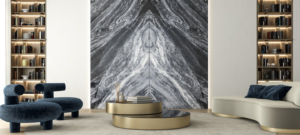
All you need to know about marble book-matching
Book-match: Definition, applications and decorative solutions
Few natural materials are as durable, timeless or undeniably beautiful as marble. This is the reason why marble has always been considered as the ideal solution for any project aspiring to provide a sense of luxury. The patterns and veining on marble surfaces can be used in a variety of ways. Depending on processing and installation techniques, they can give distinctive results, that diverge from our conventional, traditional conceptions about marble.
A particularly prevalent technique of marble installation and display is the “open book” process, also known as “book-matching”. But what exactly does this technique entail? Which marbles are suitable for book-matching and for what types of application? Read on to learn everything you need to know about marble book-matching.
What is the marble book-matching technique?
Book-matching (or open book) is a term with a long history in the marble industry, but is also used in the world of architects, decorators and constructors.
Book-matching refers to the technique of matching two or four marble slabs, whose adjoining surfaces mirror each other, creating the impression of an open book. The patterns and veining of each marble surface are joined in a way that gives the impression of a single slab.

What is the process of marble book-matching?
It all starts by cutting marble blocks into symmetrical slabs. The slabs are then numbered and prepared for processing using the technique selected by the architects, decorators or managers of each project.
Essentially, the first slab in a block is polished on one side, while the adjoining slab is polished on the back side. After processing, slabs are stored in successive order, and placed facing each other.
Once the slabs comprising the “book” are laid out one next to the other, they open up, creating a coherent and comprehensive whole of complementary patterns.
It should be noted, however, that the veining and patterns of the slabs have to be matched in a way that genuinely conveys the impression of seamless continuity. The installation of book-matched slabs is a process that requires great precision, which is why it is highly advisable that it is undertaken only by experts. Clearly, even the slightest discontinuity between slabs can undermine the project and the intended aesthetic effect.
Which marbles are suitable for book-matching?
Physically, marble is composed of various inorganic minerals such as iron oxides that appear as grains or layers on the marble surface. These natural processes account for the unique patterns seen on marble slabs.
On account of their unique formations, marble types differ in three main respects:
1. Background colour (white, dark, colourful, etc.)
2. Veining (parallel, diagonal or multidirectional veins)
3. Type of pattern (rich, shapely, austere, etc.).
In design, book-matching is selected when the intention is to create a “unique”’ aesthetic effect. This is why only marbles with surface veining and patterning are considered suitable for this technique. The directionality of the veins, the uniformity, dynamics or, more broadly, the aesthetics of the pattern can inspire architects, decorators and project managers to create different combinations. It is truly striking how different layouts of the same marble slabs used in this particular technique can result in diverse aesthetic effects.
In the photo below you can see how book-matching can produce diverse outcomes simply by installing the same slabs in different ways.
Therefore, it is the beautiful background veining and patterning of each marble, rather than its technical attributes, that determine whether it is suitable for an ‘Open Book’ display. This is why uniformly coloured marbles, despite their undeniable beauty and quality, are not recommended for book-matching. A characteristic example is Thassos, a Greek white marble variety. Despite its great beauty and immense popularity and versatility, the absence of veins or patterns from its snow-white background renders it unsuitable for open book applications.
Applications and decorative solutions using book-matched marbles
Marble is a spellbinding stone, capable of giving a sense of luxury to any space. The book-matching technique can be used to achieve truly stunning results.
Traditionally, architects and interior designers installed book-matched slabs on large surfaces and spaces that would “do justice” to their project. Book-matching applications are typically seen in hotel lobbies, corporate offices, restaurants and commercial buildings.
In recent years, however, thanks to a more contemporary approach to interior design, book-matching has also been applied in smaller interiors. The variety of book-matching applications has been rapidly expanding in interior design, with marble emerging as the ultimate natural work of art. We are seeing an ever-increasing number of novel applications of book-matching, which is used, for example, in wall cladding and flooring in living rooms, kitchens, bedrooms, bathrooms and other spaces.
Such applications offer a new, modern approach to contemporary architecture and interior and exterior design.
In the photos below you can see interior design book-matching applications.
Depending on the requirements of your specific project, we, at Stone Group International, can help you choose the marble slabs, recommend appropriate processing and advise you on installation.







